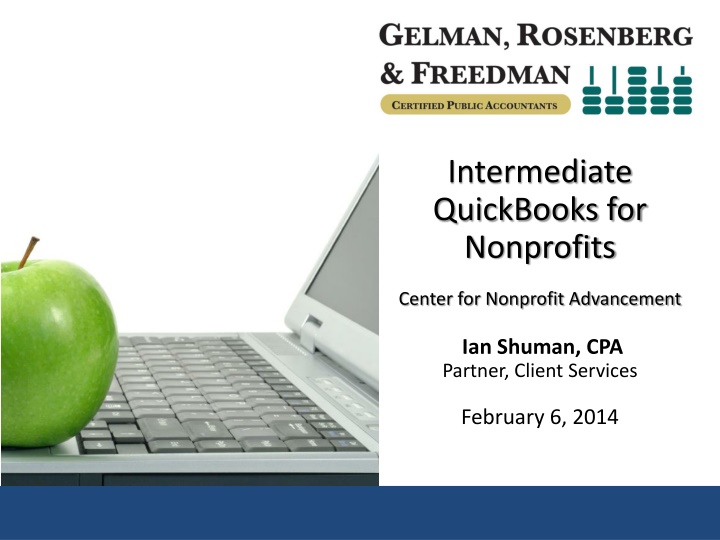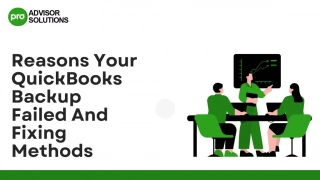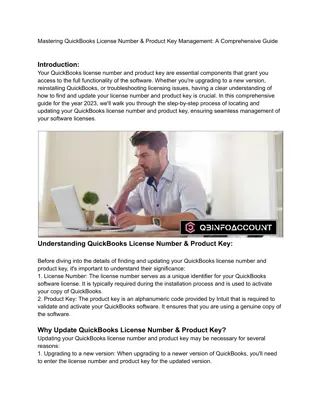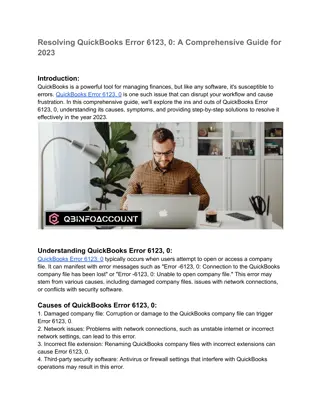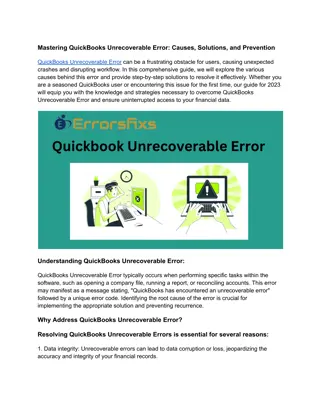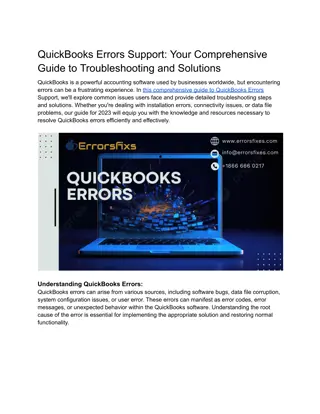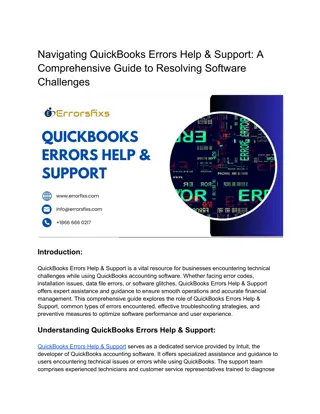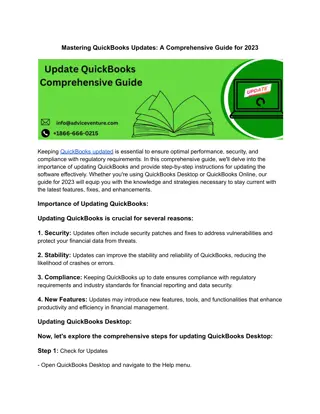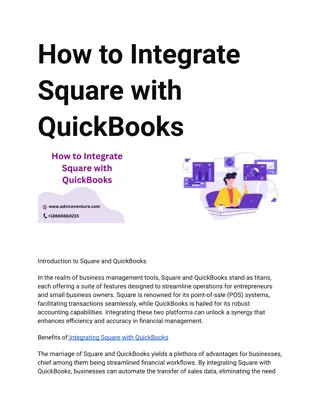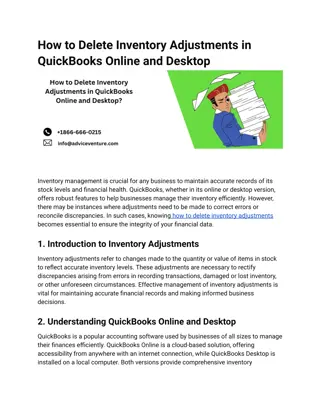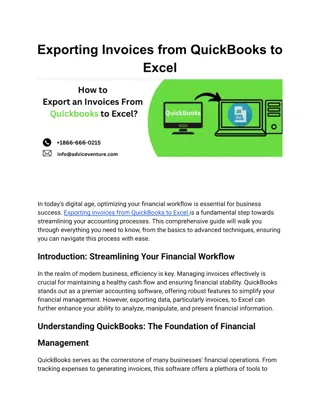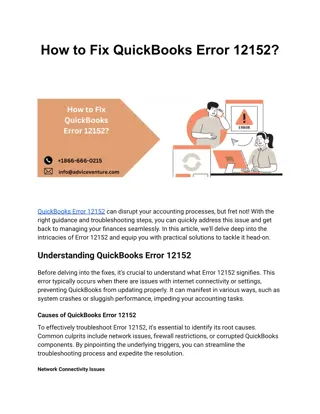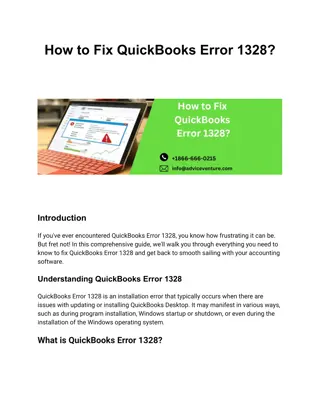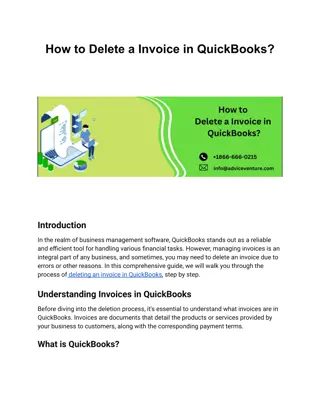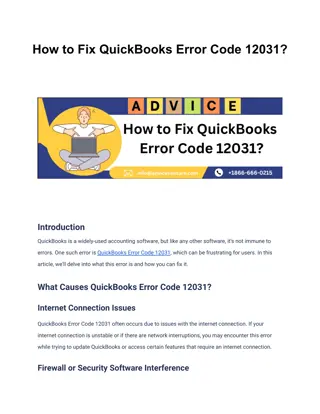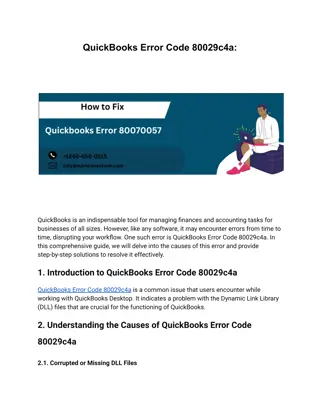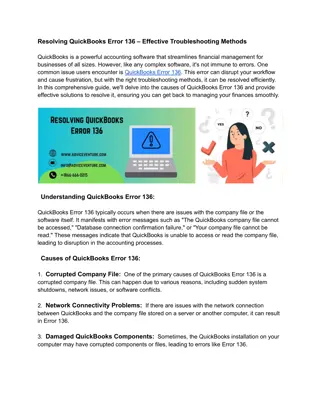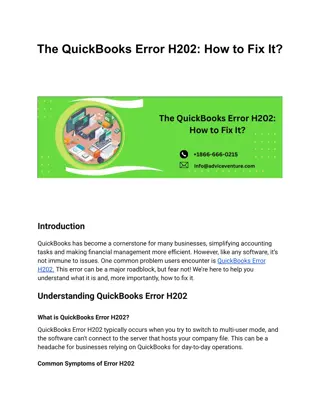Intermediate QuickBooks for Nonprofits
QuickBooks workshop on budgeting, expense management, and financial reporting for nonprofits led by Ian Shuman, CPA Partner at Gelman, Rosenberg & Freedman CPAs. Topics include using classes and jobs, expense allocations, and recording restricted P&L activity. Learn about file extensions and common QuickBooks errors specific to nonprofit accounting.
Download Presentation

Please find below an Image/Link to download the presentation.
The content on the website is provided AS IS for your information and personal use only. It may not be sold, licensed, or shared on other websites without obtaining consent from the author.If you encounter any issues during the download, it is possible that the publisher has removed the file from their server.
You are allowed to download the files provided on this website for personal or commercial use, subject to the condition that they are used lawfully. All files are the property of their respective owners.
The content on the website is provided AS IS for your information and personal use only. It may not be sold, licensed, or shared on other websites without obtaining consent from the author.
E N D
Presentation Transcript
Intermediate QuickBooks for Nonprofits Center for Nonprofit Advancement Ian Shuman, CPA Partner, Client Services February 6, 2014
Intermediate QuickBooks for Nonprofits February 6, 2014 Center for Nonprofit Advancement Ian Shuman, CPA Partner, Gelman, Rosenberg & Freedman CPAs Director of Client Services 20 years of experience in auditing, consulting and accounting Specializes in nonprofit outsourced accounting services Flexible CFO & controllership engagements, guide clients through external audit, help with board reporting, training of client accounting personnel and set up of accounting systems Nonprofit Involvement: Treasurer of the Bach Sinfonia Former Treasurer of the Sitar Arts Center Ian Shuman, CPA Gelman, Rosenberg & Freedman CPAs 2
Intermediate QuickBooks for Nonprofits February 6, 2014 Center for Nonprofit Advancement Agenda 1. Reference material 2. Budgeting 3. Using Classes and Jobs 4. Functional classification of expenses 5. Expense allocations 6. Recording restricted P&L activity 7. Presentation of net assets 8. Eighteen common QuickBooks errors Ian Shuman, CPA Gelman, Rosenberg & Freedman CPAs 3
Intermediate QuickBooks for Nonprofits February 6, 2014 Center for Nonprofit Advancement 1. Reference Material Ian Shuman, CPA Gelman, Rosenberg & Freedman CPAs 4
Intermediate QuickBooks for Nonprofits February 6, 2014 Center for Nonprofit Advancement QuickBooks File Extensions QBW - Normal Working file QBB - Full backup file QBM - A Portable File meant for emailing (missing some preferences, log and indexing) QBX - Accountant s copy you create and send to an external accountant (to work concurrently) QBA - The accountant s copy that the external accountant is working in QBY - File that the external account sends back to you to import their changes (small file) QBMB - Backup for Macintosh Ian Shuman, CPA Gelman, Rosenberg & Freedman CPAs 5
Intermediate QuickBooks for Nonprofits February 6, 2014 Center for Nonprofit Advancement QuickBooks Features by Year Be aware of Intuit s three-year Sunset policy for tech support 2006: Always-on audit trail, Centers 2007: Minor improvements 2008: Big improvements to accountant s copy 2009: Some multi-currency, prompt to close, sorting in bank reconciliations 2010: Bolds uncleared items on bank reconciliations screen, added Save to most forms 2011: Added a history pane on forms, limited B/S by class, batch invoicing 2012: Inventory center, document attachment, calendar view, simpler creation of credit memos (A/R) Ian Shuman, CPA Gelman, Rosenberg & Freedman CPAs 6
Intermediate QuickBooks for Nonprofits February 6, 2014 Center for Nonprofit Advancement QuickBooks Features By Year (cont.) 2013: Collapse report line items, visual layout changes throughout (bigger font, wider rows, icon bar left or top, changes to layout of centers), improved transaction toolbar, maximize transactions, Journal entry import (from Acct version only but no need for Acct s Copy) 2014: Added the Income Tracker dashboard, bounced customer checks, more reports in transaction toolbar, can resize or sort the time/cost window, can fit report to # pages high (instead of just width) Ian Shuman, CPA Gelman, Rosenberg & Freedman CPAs 7
Intermediate QuickBooks for Nonprofits February 6, 2014 Center for Nonprofit Advancement QuickBooks Versions Pro - Most common Premier - Saves reconciliations as PDF, allows reversing entries, subtotals journal entry debits/credits, about 2x price Nonprofit version is same as Premier with very little added Enterprise - Much stronger database Online - Different interface (one window at a time); limitations on manual imports but fantastic at automatic imports/synchs; new layout is much better but I still prefer the desktop version Sideways compatible (except online edition) but not between years Ian Shuman, CPA Gelman, Rosenberg & Freedman CPAs 8
Intermediate QuickBooks for Nonprofits February 6, 2014 Center for Nonprofit Advancement Technical Specs/Requirements 2.4 GHz processor (2 GHz minimum) 2 GB RAM (1 GB minimum) 2.5 GB disk space Windows Vista, 7 or 8 (note that they no longer list XP as officially supported) Windows 8 is supported on only the 2013 or 2014 version of QuickBooks Ian Shuman, CPA Gelman, Rosenberg & Freedman CPAs 9
Intermediate QuickBooks for Nonprofits February 6, 2014 Center for Nonprofit Advancement 2. Budgeting Ian Shuman, CPA Gelman, Rosenberg & Freedman CPAs 10
Intermediate QuickBooks for Nonprofits February 6, 2014 Center for Nonprofit Advancement Creating Budgets Go to Company/Planning and Budgeting/Set Up Budgets - then select year You can create up to three distinct and completely separate budgets for the same year o Budget by account (company as a whole) o Budget by account and job o Budget by account and class Budgets for multiple classes or multiple jobs are cumulative within the budget by account and job or class Ian Shuman, CPA Gelman, Rosenberg & Freedman CPAs 11
Intermediate QuickBooks for Nonprofits February 6, 2014 Center for Nonprofit Advancement Creating Budgets (cont.) Rows are always the Chart of Accounts (COA) and columns are always the months If you don t break down your budget by month, then consider putting the entire amount in January Notice that you can do math inside a cell and you can use the Copy Across button Ian Shuman, CPA Gelman, Rosenberg & Freedman CPAs 12
Intermediate QuickBooks for Nonprofits February 6, 2014 Center for Nonprofit Advancement Creating Budgets- data input screen Ian Shuman, CPA Gelman, Rosenberg & Freedman CPAs 13
Intermediate QuickBooks for Nonprofits February 6, 2014 Center for Nonprofit Advancement Three Report Options Budget Overview - Shows just the budget data Budget vs Actual - Shows actual and budget for any given time period o You choose what fiscal year and which budget o You choose account/month, account/class or class/month (rows/columns) o Can do columns by time periods within the fiscal year just like normal P&L reports o Optionally, you can add the variance in $ and % Ian Shuman, CPA Gelman, Rosenberg & Freedman CPAs 14
Intermediate QuickBooks for Nonprofits February 6, 2014 Center for Nonprofit Advancement Three Report Options (cont.) Profit & Loss (P&L) Budget Performance Same as above but also shows the same information for year to date and also includes the full annual budget. You have the same options as above. Note: This report is unique within QuickBooks in that it contains data outside of the defined time period. Ian Shuman, CPA Gelman, Rosenberg & Freedman CPAs 15
Intermediate QuickBooks for Nonprofits February 6, 2014 Center for Nonprofit Advancement Budget Overview Report Ian Shuman, CPA Gelman, Rosenberg & Freedman CPAs 16
Intermediate QuickBooks for Nonprofits February 6, 2014 Center for Nonprofit Advancement Budget vs. Actual Report Ian Shuman, CPA Gelman, Rosenberg & Freedman CPAs 17
Intermediate QuickBooks for Nonprofits February 6, 2014 Center for Nonprofit Advancement Profit & Loss Budget Performance Ian Shuman, CPA Gelman, Rosenberg & Freedman CPAs 18
Intermediate QuickBooks for Nonprofits February 6, 2014 Center for Nonprofit Advancement Budget Variances Are always shown as actual minus budget (positive variances are good for revenue and bad for expenses) that s backwards if you think in terms of Budget Remaining Suggestion: Consider adding a zero for every account without a budget. Reports will not calculate a budget variance for a row that has no budget even if there is an actual figure! Total variance will still be correct. Ian Shuman, CPA Gelman, Rosenberg & Freedman CPAs 19
Intermediate QuickBooks for Nonprofits February 6, 2014 Center for Nonprofit Advancement 3. Classes and Jobs Ian Shuman, CPA Gelman, Rosenberg & Freedman CPAs 20
Intermediate QuickBooks for Nonprofits February 6, 2014 Center for Nonprofit Advancement What They Both Are Think of them as two other ways besides the chart of accounts that can categorize revenue and expense activity into categories These are then available to become separate columns in a Profit & Loss report Adds a field to every transaction - Each one is a separate dropdown list with user-defined content Ian Shuman, CPA Gelman, Rosenberg & Freedman CPAs 21
Intermediate QuickBooks for Nonprofits February 6, 2014 Center for Nonprofit Advancement What They Both Are (cont.) List is in outline form and can be modified at any time (be aware of retroactive changes) Replaces the use of Department Codes or Project Codes (ex: 6300-25) Note that you can do journal entries within the same account of the chart of accounts but coded to different classes (or jobs) Ian Shuman, CPA Gelman, Rosenberg & Freedman CPAs 22
Intermediate QuickBooks for Nonprofits February 6, 2014 Center for Nonprofit Advancement Why Classes are Better No column or report for Not Assigned to a Customer if you do P&L by job On transaction reports, jobs share the Name field with vendor and/or customer Ian Shuman, CPA Gelman, Rosenberg & Freedman CPAs 23
Intermediate QuickBooks for Nonprofits February 6, 2014 Center for Nonprofit Advancement Why Jobs are Better Expenses coded to a customer can be pulled directly onto an invoice Some 3rd party time/billing applications require jobs and won t work with classes Ian Shuman, CPA Gelman, Rosenberg & Freedman CPAs 24
Intermediate QuickBooks for Nonprofits February 6, 2014 Center for Nonprofit Advancement How to Use Them They are both completely optional; you can use either, neither or both Think about how you need to divide costs - Can you do it in one outline list? Using the chart of accounts, classes and jobs can become complicated so it s easier if you don t need all three Ian Shuman, CPA Gelman, Rosenberg & Freedman CPAs 25
Intermediate QuickBooks for Nonprofits February 6, 2014 Center for Nonprofit Advancement Common Examples To divide costs by functional classification, by program or by funder To create cost pools for allocations Often used for tracking restrictions I almost always use classes for these issues and then add jobs if necessary Ian Shuman, CPA Gelman, Rosenberg & Freedman CPAs 26
Intermediate QuickBooks for Nonprofits February 6, 2014 Center for Nonprofit Advancement 4. Functional Classification of Expenses Ian Shuman, CPA Gelman, Rosenberg & Freedman CPAs 27
Intermediate QuickBooks for Nonprofits February 6, 2014 Center for Nonprofit Advancement Background (example) Carwash for Good Statement of Functional Expenses For the Year Ended December 31, 2013 Program Services Treatment Advocacy Admin. Total Expenses Salary Consultants Travel Program Materials Rent $ 5,050 1,600 $ 1,500 $ 450 $ 7,000 2,000 300 200 - - 100 - - 500 500 300 700 300 500 - Total Expenses $ 7,450 $ 2,000 $ 1,050 $ 10,500 Ian Shuman, CPA Gelman, Rosenberg & Freedman CPAs 28
Intermediate QuickBooks for Nonprofits February 6, 2014 Center for Nonprofit Advancement Using the Chart of Accounts One long list of accounts with separate sections for program, administrative and fundraising Can still use jobs or classes for tracking of individual projects This is good because: o Reports are very visual and easy to follow Ian Shuman, CPA Gelman, Rosenberg & Freedman CPAs 29
Intermediate QuickBooks for Nonprofits February 6, 2014 Center for Nonprofit Advancement Using the Chart of Accounts o Keeps actual information in one column o Easiest way to produce a statement of activities (but can t break out by program without making chart of account quite long) o Auditors like it This is bad because: o Data entry errors become more likely (because there are multiple accounts for similar types of expenses) Ian Shuman, CPA Gelman, Rosenberg & Freedman CPAs 30
Intermediate QuickBooks for Nonprofits February 6, 2014 Center for Nonprofit Advancement Using the Chart of Accounts (cont.) o Harder to get subtotals by natural accounts (ex: there may be three different Printing accounts) o Makes the chart of accounts longer o You may not always want this as rows of a report (ex: Expand / Collapse becomes less useful) o You may be using jobs/classes anyway to track individual programs Ian Shuman, CPA Gelman, Rosenberg & Freedman CPAs 31
Intermediate QuickBooks for Nonprofits February 6, 2014 Center for Nonprofit Advancement Using Either Jobs or Classes Expense accounts are rows and the functional classification is in different columns Job or class list would be an outline with three main categories Sound familiar? Filter out the revenue accounts and that s a statement of functional expenses Ian Shuman, CPA Gelman, Rosenberg & Freedman CPAs 32
Intermediate QuickBooks for Nonprofits February 6, 2014 Center for Nonprofit Advancement Using Either Jobs or Classes A bit of a challenge visually but keeps the chart of accounts very simple and minimizes data entry errors Tip: Either way you can always use filters to select only a single program to get a project-specific P&L report. Ian Shuman, CPA Gelman, Rosenberg & Freedman CPAs 33
Intermediate QuickBooks for Nonprofits February 6, 2014 Center for Nonprofit Advancement 5. Expense Allocations Ian Shuman, CPA Gelman, Rosenberg & Freedman CPAs 34
Intermediate QuickBooks for Nonprofits February 6, 2014 Center for Nonprofit Advancement Background Nonprofits often need to gather costs (sometimes into a Pool ) and then allocate those costs to other areas. Examples are labor, fringe and OH. One option is to code every transaction using a certain split (ex: 40% program 1 and 60% program 2)- but that s time consuming and prone to errors Ian Shuman, CPA Gelman, Rosenberg & Freedman CPAs 35
Intermediate QuickBooks for Nonprofits February 6, 2014 Center for Nonprofit Advancement Background (cont.) Another option is to do a separate journal entry to spread costs for each expense account (each row) Or you can define a particular class or job as a cost pool and then allocate the whole column at once Ian Shuman, CPA Gelman, Rosenberg & Freedman CPAs 36
Intermediate QuickBooks for Nonprofits February 6, 2014 Center for Nonprofit Advancement Example: Fringe Benefit Allocations A journal entry can move costs out of the fringe class and into others within the same expense account- here called allocated fringe costs . Ian Shuman, CPA Gelman, Rosenberg & Freedman CPAs 37
Intermediate QuickBooks for Nonprofits February 6, 2014 Center for Nonprofit Advancement Ex: Fringe Benefit Allocations (cont.) What s the fringe rate? In this example, fringe costs total $720 and will be allocated using a base of wages (other than fringe). The base totals $7,200. The Fringe Rate then is pool/base = 720/7200 = 10%. The total costs in the class Fringe become your check figure - if the class totals zero then you ve probably done the journal entries correctly. Ian Shuman, CPA Gelman, Rosenberg & Freedman CPAs 38
Intermediate QuickBooks for Nonprofits February 6, 2014 Center for Nonprofit Advancement Ex: Fringe Benefit Allocations (cont.) You can also check that the rate is the same in each class Functionally, fringe costs could be part of admin or (better yet) outside of the functional areas completely because you ve moved those costs to all the other areas. Ian Shuman, CPA Gelman, Rosenberg & Freedman CPAs 39
Intermediate QuickBooks for Nonprofits February 6, 2014 Center for Nonprofit Advancement Example: Overhead Allocations Same methodology- Costs are gathered in a pool and spread to other areas Ian Shuman, CPA Gelman, Rosenberg & Freedman CPAs 40
Intermediate QuickBooks for Nonprofits February 6, 2014 Center for Nonprofit Advancement Ex: Overhead Allocations (cont.) What s the overhead rate? In this example, overhead costs total $500 (the pool) and will be allocated using a base of total ordinary expenses. The base totals $5,000. The Overhead Rate then is pool/base = 500/5000 = 10%. I use Other Expenses simply because you often need a subtotal with and without allocated overhead. Ian Shuman, CPA Gelman, Rosenberg & Freedman CPAs 41
Intermediate QuickBooks for Nonprofits February 6, 2014 Center for Nonprofit Advancement Ex: Overhead Allocations (cont.) If you need to charge different rates to different projects you have two rows: Billable and Difference . Tip: this should not reduce Admin to zero in functional expense reporting! Ian Shuman, CPA Gelman, Rosenberg & Freedman CPAs 42
Intermediate QuickBooks for Nonprofits February 6, 2014 Center for Nonprofit Advancement 6. Recording Restricted Activity Ian Shuman, CPA Gelman, Rosenberg & Freedman CPAs 43
Intermediate QuickBooks for Nonprofits February 6, 2014 Center for Nonprofit Advancement Carwash for Good Statement of Activities For the Year Ended December 31, 2012 Temporarily Unrestricted Restricted Total Revenue Contributions Interest income Release from restriction $ 4,500 $ 10,500 $ 15,000 100 9,000 - 100 - (9,000) Total Revenue 13,600 1,500 15,100 Expenses Treatment Advocacy 7,450 2,000 - - 7,450 2,000 Total Program Expenses 9,450 - 9,450 Administration 1,050 - 1,050 Total Expenses 10,500 - 10,500 Change in Net Assets $ 3,100 $ 1,500 $ 4,600 Ian Shuman, CPA Gelman, Rosenberg & Freedman CPAs 44
Intermediate QuickBooks for Nonprofits February 6, 2014 Center for Nonprofit Advancement Background Restricted = When a donor tells the recipient how or when they can use a contribution GAAP requires recognition of unconditional contributions, even when restricted or for multiple years The restricted activity is considered to be Released when a recipient fulfills the donor s restrictions Ian Shuman, CPA Gelman, Rosenberg & Freedman CPAs 45
Intermediate QuickBooks for Nonprofits February 6, 2014 Center for Nonprofit Advancement Background (cont.) This is complicated to understand and often contradicts how nonprofits budget revenue So there is a need to track restricted activity segregated from unrestricted activity but management and board still need to understand the reports! Ian Shuman, CPA Gelman, Rosenberg & Freedman CPAs 46
Intermediate QuickBooks for Nonprofits February 6, 2014 Center for Nonprofit Advancement Option One: Use Jobs/Classes Can leave restricted contributions in the same revenue accounts and just track it in jobs/classes. VERDICT: Total revenue is correct, might contradict budget, but doesn t show releases from restriction or track restricted balances Ian Shuman, CPA Gelman, Rosenberg & Freedman CPAs 47
Intermediate QuickBooks for Nonprofits February 6, 2014 Center for Nonprofit Advancement Option Two: Deferred Revenue Record restricted activity as a liability (like deferred revenue) and move to revenue when released. The $500 is no longer in revenue. VERDICT: Tracks releases from restriction and balances, often aligns with budgeting but can be confusing and total revenue is incorrect Ian Shuman, CPA Gelman, Rosenberg & Freedman CPAs 48
Intermediate QuickBooks for Nonprofits February 6, 2014 Center for Nonprofit Advancement Option Three: Separate Revenue Accounts Separate revenue accounts within the same revenue section but otherwise similar to option #1 with activity tracked in jobs/classes VERDICT: Slightly better but same verdict as #1, above Ian Shuman, CPA Gelman, Rosenberg & Freedman CPAs 49
Intermediate QuickBooks for Nonprofits February 6, 2014 Center for Nonprofit Advancement Option Four: Restricted as Other Income Ian Shuman, CPA Gelman, Rosenberg & Freedman CPAs 50
